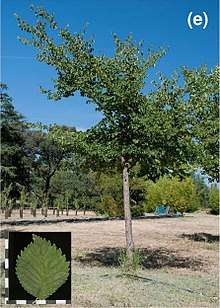''Ulmus minor'' 'Dehesa de Amaniel'
| Ulmus minor 'Dehesa de Amaniel' | |
|---|---|
 'Dehesa de Amaniel' | |
| Species | Ulmus minor |
| Cultivar | 'Dehesa de Amaniel' |
| Origin | Spain |
The Field Elm cultivar Ulmus minor 'Dehesa de Amaniel' was raised from seed collected in 1999 from a tree growing in the Dehesa de la Villa park (40°27′37″N 3°43′17″W / 40.46028°N 3.72139°W),[1] within the Moncloa-Aravaca district of north-west Madrid by researchers at the Escuela Técnica Superior de Ingenieros de Montes, Universidad Politėcnica de Madrid. 'Dehesa de Amaniel' is one of a number of Spanish Ulmus minor found to have a very high resistance to Dutch Elm Disease, on a par with, if not greater than, the hybrid cultivar 'Sapporo Autumn Gold'. However, in the Madrid study, the appearance of the tree was rated 3 / 5, the lowest score of all the trialled cultivars. [1]
'Dehesa de Amaniel' was introduced to the UK in 2015, by Hampshire & Isle of Wight Branch, Butterfly Conservation, as part of an assessment of DED-resistant cultivars as potential hosts of the endangered White-letter Hairstreak.[2]
Description
'Dehesa de Amaniel' grew at a comparatively fast rate of 90 cm per annum at the Puerta de Hierro nursery in Madrid. The spreading branches, which have corky tissue, form an irregular crown. The leaves, on 2.5 mm petioles, are round, typically oblique at the base and acuminate at the apex, the average length and width 39 × 30 mm, the margins triple-serrate. The leaves are relatively sparsely distributed along the branchlets, and suffused dark-red on emergence, distinguishing them from the other selected Madrid clones. Foliar density relative to 'Sapporo Autumn Gold' is described as 'high'. [1]
 'Dehesa de Amaniel' leaf
'Dehesa de Amaniel' leaf Emergent foliage
Emergent foliage Corky bark
Corky bark
Pests and diseases
'Dehesa de Amaniel' is the most resistant of the Spanish U. minor clones to Dutch elm disease, with wilting values below 5% during the two consecutive inoculation trials performed in Madrid.[1]
Cultivation
'Dehesa de Amaniel' is undergoing further trials in other, different, environments in Spain, where it was tested by inoculation in 2016. If the performance of the cultivar remains satisfactory, the tree will be released to commerce under licence. 'Dehesa de Amaniel' is also being assessed as part of Butterfly Conservation's elm trials in southern Hampshire, England.[2]
Etymology
The tree's name commemorates the former owner of Dehesa (:'grassland') de la Villa, Lope de Amaniel, ballestero of Henry II of Castile.
References
- 1 2 3 4 Martín, JA; Solla, A; Venturas, M; Collada, C; Domínguez, J; Miranda, E; Fuentes, P; Burón, M; Iglesias, S; Gil, L (2015-04-01). "Seven Ulmus minor clones tolerant to Ophiostoma novo-ulmi registered as forest reproductive material in Spain". iForest - Biogeosciences and Forestry. Italian Society of Sivilculture and Forest Ecology (SISEF). 8 (2): 172–180. doi:10.3832/ifor1224-008. ISSN 1971-7458.
- 1 2 Brookes, A. H. (2017). Great Fontley Elm Trial, 2017 Report. Butterfly Conservation, Lulworth, England.